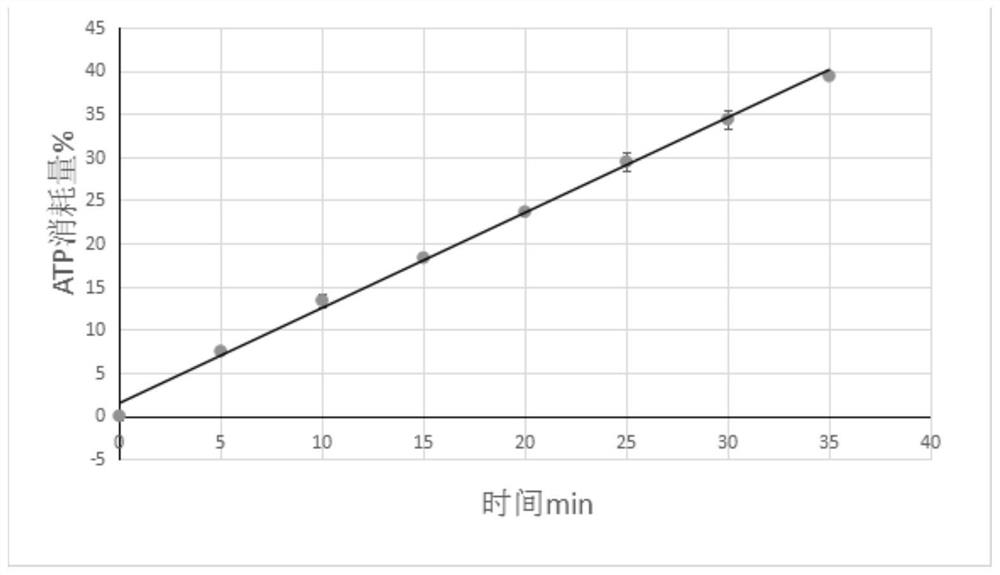Method and Application of Monitoring mRNA Poly(A) Tail Length
A tail reaction and reaction technology, applied in the field of monitoring the tail length of mRNAPoly, can solve the problems of high cost and time-consuming, and achieve the effects of intuitive results, low detection cost, and simple and efficient detection.
- Summary
- Abstract
- Description
- Claims
- Application Information
AI Technical Summary
Problems solved by technology
Method used
Image
Examples
Embodiment 1
[0100] Example 1 Using bioluminescence to detect ATP consumption and control tail length
[0101] 1. Standard tailing reaction
[0102] S1. Prepare ATP detection working solution
[0103] Prepare an appropriate amount of ATP detection working solution according to the ratio of 100 μl ATP detection working solution required for each sample. Take an appropriate amount of ATP detection reagent and dilute the ATP detection reagent with ATP detection reagent diluent in a ratio of 1:9. For example, 100 μl of ATP detection reagent is added to 900 μl of ATP detection reagent diluent to prepare 1 ml of ATP detection working solution. The detection working solution should be placed at room temperature for 3-5 minutes before use.
[0104] S2, build a standard tailing reaction
[0105] 500 μM ATP was added to the tailing reaction with a constant concentration of 0.6 μM mRNA for the reaction. When the reaction time was 0, 5, 10, 15, 20, 25, 30, and 35 min, 10 μl was sampled and added t...
experiment example 1
[0119]In this experimental example, Bioanalyzer was used to sample the samples at the 15th, 17th and 20th minutes in the above-mentioned pilot-scale reaction, and then analyzed, and the detection results of the two methods were compared. The results are shown in Table 2 and Figure 10 shown, from Figure 10 It can be seen that the values obtained by the two detection methods provided in Example 1 and Comparative Example 1 are very close. As can be seen from Table 2, among the detection methods provided in the comparative example, pretreatment is required before sample detection, and the techniques to be used include capillary electrophoresis, etc. These techniques require a relatively complex sample preparation process, and the instruments are relatively expensive. The cost is high, and the entire inspection process takes a long time, which cannot achieve the purpose of real-time quality feedback, thereby controlling product quality. However, the detection method provided i...
Embodiment 2
[0122] Example 2 The effect of tail length on stable expression of intracellular proteins
[0123] This example evaluates the effect of tail length on stable expression of intracellular proteins and its potential impact on the efficacy of mRNA-based therapies. Specifically, the protein expression levels of mRNAs with different tail lengths in cells were evaluated. mRNA was synthesized from a plasmid DNA template encoding the gene by in vitro transcription, with the addition of a 5' cap structure and Poly(A) tails of various lengths.
[0124] HEK293 cells were plated at a density of 8 × 10 5 pcs / well, at 37°C, 5.0% CO 2 overnight in the incubator. Then the medium was replaced, the cell plate was taken out and the medium was sucked off, then fresh medium was added, and placed at 37°C, 5.0% CO. 2 incubator. Solution A: Mix 2 μg mRNA in 100 μl Opti-MEM medium, Solution B: Mix 3 μl Lipo MessengerMax with 100 μl Opti-MEM medium, Mix A and B evenly, and let stand at room tempera...
PUM
 Login to View More
Login to View More Abstract
Description
Claims
Application Information
 Login to View More
Login to View More - R&D
- Intellectual Property
- Life Sciences
- Materials
- Tech Scout
- Unparalleled Data Quality
- Higher Quality Content
- 60% Fewer Hallucinations
Browse by: Latest US Patents, China's latest patents, Technical Efficacy Thesaurus, Application Domain, Technology Topic, Popular Technical Reports.
© 2025 PatSnap. All rights reserved.Legal|Privacy policy|Modern Slavery Act Transparency Statement|Sitemap|About US| Contact US: help@patsnap.com



